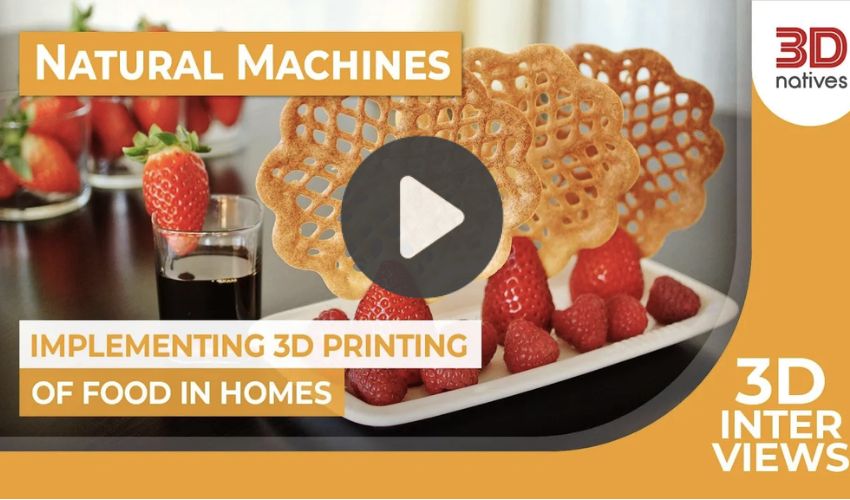Top 5 3D Printing Videos: Food 3D Printing with Natural Machines

Hello everybody, and welcome to our top 5 3D printing videos of the week! Spring is in the air, and in our content too. This week, we have an exciting selection ranging from technical comparisons of different techniques, to practical applications of 3D printing to create smart products with the hope of improving the life of the user – in this case, a 3D printed smart insole. We also have a 3Dnatives original video, a #3dinterview on the topic of food 3D printing with Natural Machines. We hope you enjoy.
Top 1: Natural Machines on Food 3D Printing
As well as selecting the best videos on the market each week, we are proud to bring you original content from our own studio. This week we interviewed Lynette Kucsma of Natural Machines, a firm which makes 3D printing a reality for the health and wellness industry. She told us all about the potential of food 3D printing for localized production of products; indeed, what could be more local than your own home? The firm’s printer, allowing people to take this step, is named ‘Foodini’. She emphasized the similarity between 3D printed and traditional food, and told us about her belief that the technology holds the potential to become the new normal method to make products, instead of a manufacturing line.
Top 2: Cost Comparison of FDM vs SLA vs SLS
Our second video of the week is for the technical enthusiasts – a cost comparison of 3 different printing techniques for plastics, FDM, SLA, and SLS. This video gives you a run through of the variables which can affect the cost. Firstly, they look at equipment ownership, meaning the fixed cost of the printer, the service contracts, installation, and maintenance, and then give an approximate costing of each option. Secondly, there is the cost of materials and consumables. Finally, there are labor costs such as those associated with set-up, maintenance, and post-processing. Overall – FDM will be cheapest for simple prototypes in low numbers, whereas SLS is the most cost-effective for medium to large volumes of higher quality parts.
Top 3: 3D-Printed Insoles Track Weight Bearing
3D printing plays an important role in the development of customized products, and even medical devices; many fabricators also integrate electronics in order to create an intelligent product. In this video, we learn that researchers from ETH Zurich (a Swiss University), Empa (the Swiss Federal Laboratories for Materials Science and Technology) and EPFL (Swiss Federal Institute of Technology Lausanne) have developed smart 3D printed insoles! The insoles feature sensors to measure pressure in the shoe, allowing them to detect whether the person is walking, running, climbing stairs – or even carrying something heavy. The researchers envision the product to be used in physiotherapy to measure the person’s progress.
Top 4: Full Body 3D Scanning
While most of these videos are about 3D printing, in fact 3D scanning is another crucial technique in the industry, producing high-quality models for analysis. In this video we have a demonstration from Scantech, one of the leading 3D manufacturers of scanning solutions, on how to use their product for a full body scan using the iReal 2E. The advantages of the product, as we hear in the video, are that the scans are invisible and it can adapt to every feature of the person such as hairstyles and hair color. The second half of the video is a demonstration of the scanner in use.
Top 5: 3D Printing for Organ Transplants
3D printing in the mainstream media is an important way for innovation and technology to be disseminated to those outside of the industry. This video focuses on the application of the technology for organ transplants, with an interview with Dr Akshay Syal, who tells us all about how it works and what this means for the future. As he puts it, this could be a way to solve the shortage of viable organs for transplant, and he also reminds us that with 3D bioprinted organs there is no need for the patient to take immunosuppressant drugs. If you want a recap on how bioprinting actually works just watch on, as the doctor gives a succinct and accessible explanation of the printing process! He believes we are 10 years out from this being a reality.
What did you think of this week’s selection of 3D printing videos, including our 3Dnatives original interview on Natural Machines’ food 3D printing? Let us know in a comment below or on our LinkedIn, Facebook, and Twitter pages! Don’t forget to sign up for our free weekly Newsletter here, the latest 3D printing news straight to your inbox! You can also find all our videos on our YouTube channel.






